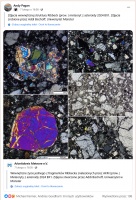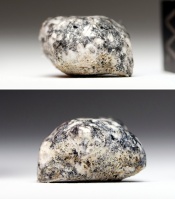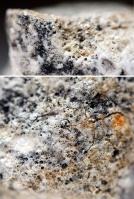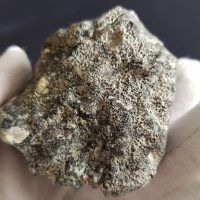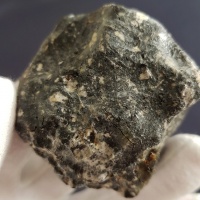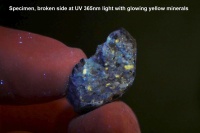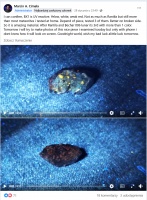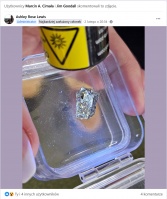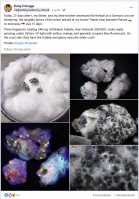(Unless otherwise stated, the copyright of the materials included belong to Jan Woreczko & Wadi.)
Ribbeck/Badania
Z Wiki.Meteoritica.pl
m (→Skorupa obtopieniowa) |
|||
| Linia 4: | Linia 4: | ||
=== Mineralogia === | === Mineralogia === | ||
| + | |||
| + | Za {{!MBD}}: | ||
| + | {{BQuote-begin |max-width=800px}} | ||
| + | '''Petrography''': (A. Greshake, C. Hamann, L. Hecht, ''MNB'') The meteorite is a coarse-grained achondritic breccia predominantly composed of large, up to 1.2 cm sized, mostly angular whitish enstatite grains, less abundant, up to 1.5 mm sized forsterite crystals, and minor sodic feldspar set in a fine-grained interstitial cataclastic matrix consisting of related material. Opaque phases include troilite, alabandite, oldhamite, heideite, keilite, djerfisherite, kamacite, and taenite. Enstatite and forsterite show pronounced undulatory extinction. All phases are intensely fractured and enstatite contains several sets of planar cracks. No diopside detected. | ||
| + | |||
| + | '''Geochemistry''': Enstatite: Fs<sub>0</sub>Wo<sub>0.7±0.1 </sub>(Fs<sub>0</sub>Wo<sub>0.6-0.9</sub>, n=10); olivine: Fa<sub>0</sub>, n=10; plagioclase: An<sub>1.4-4.8</sub>Ab<sub>93.1-96.2</sub>Or<sub>2.0-2.4</sub>, n=5); troilite contains : 0.18±0.01 wt% Cr and 0.94±0.3 wt% Ti, N=3; kamacite contains : 4.65±0.11 wt% Ni, 0.94±0.2 wt% Co, and 0.07±0.01 Si, N=3; taenite contains : 32.4±0.3 wt% Ni, 0.56±0.2 wt% Co, and 0.10±0.01 Si, N=3 | ||
| + | {{BQuote-end}} | ||
<gallery caption="" widths="200px" heights="200px" perrow="3"> | <gallery caption="" widths="200px" heights="200px" perrow="3"> | ||
| Linia 11: | Linia 18: | ||
=== Skorupa obtopieniowa === | === Skorupa obtopieniowa === | ||
| + | |||
| + | Za {{!MBD}}: | ||
| + | {{BQuote-begin |max-width=800px}} | ||
| + | '''Physical characteristics''': (A. Greshake, C. Hamann, L. Hecht, ''MNB'') The various individuals show rounded, egg-shaped, and angular shapes, have a gray-white patchy appearance and are partly to fully covered by fresh, whitish to dark grayish, often intensely cracked fusion crust. In many cases, the fusion crust contains transparent, often highly vesicular areas that appear to cover the dull gray and dull white areas in the form of thin veneers or stringers of quenched melt. Some rocks are fragmented, thereby exposing the whitish interior with large mineral grains already visible to the naked eye. | ||
| + | {{BQuote-end}} | ||
Jasna, spieniona skorupa obtopieniowa | Jasna, spieniona skorupa obtopieniowa | ||
| Linia 19: | Linia 31: | ||
File:2024_BX1_(main_mass)-KK6.jpg|Ciemna, „gładka” część skorupy masy głównej (fot. Kryspin Kmieciak) | File:2024_BX1_(main_mass)-KK6.jpg|Ciemna, „gładka” część skorupy masy głównej (fot. Kryspin Kmieciak) | ||
</gallery> | </gallery> | ||
| + | |||
=== Fluorescencja minerałów === | === Fluorescencja minerałów === | ||
| Linia 36: | Linia 49: | ||
== [[Bibliografia]] == | == [[Bibliografia]] == | ||
| + | |||
| + | * '''Meteoritical Bulletin Database ([http://www.lpi.usra.edu/meteor/metbull.php MBD])''' – meteoryt [http://www.lpi.usra.edu/meteor/metbull.php?code=81447 Ribbeck] | ||
* Kosina Romuald, (2014), '''O nieznanej naturze meteorytów (''On the unknown nature of meteorites'')''', ''Acta Soc. Metheor. Polon.'', 5, 2014, s. 72-80.<ref>o fluorescencji minerałów w meteorytach</ref> Plik {{Link-ASMP|BN=1|1033006}}. | * Kosina Romuald, (2014), '''O nieznanej naturze meteorytów (''On the unknown nature of meteorites'')''', ''Acta Soc. Metheor. Polon.'', 5, 2014, s. 72-80.<ref>o fluorescencji minerałów w meteorytach</ref> Plik {{Link-ASMP|BN=1|1033006}}. | ||
Wersja z 22:42, 17 lut 2024
Hasło powstało w oparciu o informacje dostępne na portalu facebook i dzięki życzliwości poszukiwaczy. Dziękujemy.
Mineralogia
Za Meteoritical Bulletin Database:
Petrography: (A. Greshake, C. Hamann, L. Hecht, MNB) The meteorite is a coarse-grained achondritic breccia predominantly composed of large, up to 1.2 cm sized, mostly angular whitish enstatite grains, less abundant, up to 1.5 mm sized forsterite crystals, and minor sodic feldspar set in a fine-grained interstitial cataclastic matrix consisting of related material. Opaque phases include troilite, alabandite, oldhamite, heideite, keilite, djerfisherite, kamacite, and taenite. Enstatite and forsterite show pronounced undulatory extinction. All phases are intensely fractured and enstatite contains several sets of planar cracks. No diopside detected.
Geochemistry: Enstatite: Fs0Wo0.7±0.1 (Fs0Wo0.6-0.9, n=10); olivine: Fa0, n=10; plagioclase: An1.4-4.8Ab93.1-96.2Or2.0-2.4, n=5); troilite contains : 0.18±0.01 wt% Cr and 0.94±0.3 wt% Ti, N=3; kamacite contains : 4.65±0.11 wt% Ni, 0.94±0.2 wt% Co, and 0.07±0.01 Si, N=3; taenite contains : 32.4±0.3 wt% Ni, 0.56±0.2 wt% Co, and 0.10±0.01 Si, N=3
Skorupa obtopieniowa
Za Meteoritical Bulletin Database:
Physical characteristics: (A. Greshake, C. Hamann, L. Hecht, MNB) The various individuals show rounded, egg-shaped, and angular shapes, have a gray-white patchy appearance and are partly to fully covered by fresh, whitish to dark grayish, often intensely cracked fusion crust. In many cases, the fusion crust contains transparent, often highly vesicular areas that appear to cover the dull gray and dull white areas in the form of thin veneers or stringers of quenched melt. Some rocks are fragmented, thereby exposing the whitish interior with large mineral grains already visible to the naked eye.
Jasna, spieniona skorupa obtopieniowa
Fluorescencja minerałów
Świecący w UV fragment 1,3 g Roberto Vargasa |
||
- Zdjęcie fragmentu aubrytu Norton County[1] w świetle UV: Daniel Skotnik: Northorn County Aubrite under long waved UV light:).
- Wygląd fragmentu 2024 BX1 (Ribbeck) w świetle UV 365 nm (PolandMet.com): PolandMET Meteorite RIBBECK (3.83 gram) in UV 365nm.
- Przykłady fluorescencji dwóch aubrytów Rantila[2] i Tiglit[3] w świetle UV o długościach 365 nm i 254 nm (PolandMet.com): PolandMET Meteorite RANTILA and TIGLIT aubrite observed falls in UV 365nm ● PolandMET Meteorite RANTILA and TIGLIT aubrite observed falls in UV 254nm
Bibliografia
- Kosina Romuald, (2014), O nieznanej naturze meteorytów (On the unknown nature of meteorites), Acta Soc. Metheor. Polon., 5, 2014, s. 72-80.[4] Plik ASMP.
- Spurný et al., Zánik malé planetky 2024 BX1 západně od Berlína 21. ledna 2024 zachycený kamerami Evropské bolidové sítě, portal Astronomický ústav AV ČR.
Przypisy
Zobacz również
Linki zewnętrzne
- Facebook – Asteroid 2024 BX1 - RIBBECK Meteorite
- Portal redbor.pl – Luminescencja minerałów
